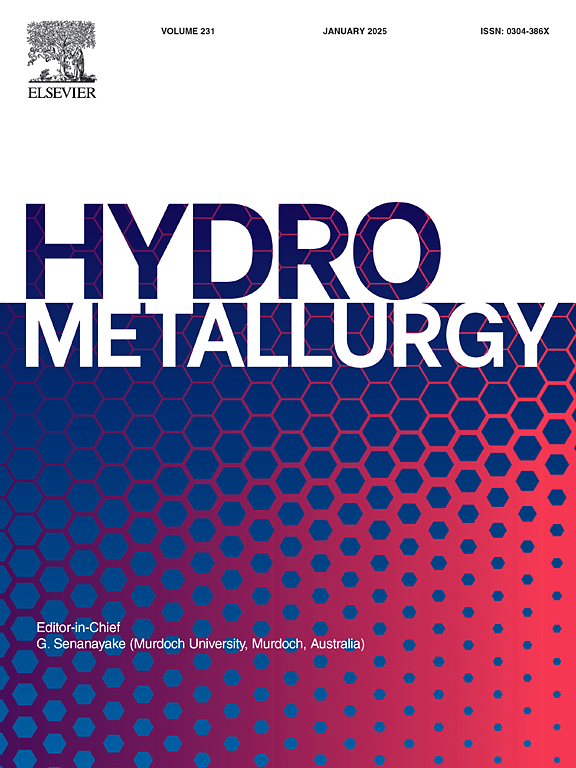硫化矿物与 Cu(II) 溶液在 H2SO4 介质中的热液处理评述
IF 4.8
2区 材料科学
Q1 METALLURGY & METALLURGICAL ENGINEERING
引用次数: 0
摘要
在酸化的硫酸铜溶液中对铜精矿进行水热预处理作为铜精矿化学富集的一种方法,早在上世纪初就已为人所知。虽然这种方法已经在中试规模上得到了验证,但有关构成这种技术基础的化学相互作用的详细研究却很少公开发表。本综述试图总结一个多世纪以来有关硫化矿物热液处理的研究数据。研究重点是酸化硫酸铜溶液与硫化矿物之间的热液相互作用,这对热液富集过程具有关键意义,包括主要的铜矿物(CuFeS2、Cu5FeS4、CuS、Cu2S)以及通常作为惩罚性杂质与铜精矿伴生的矿物(如 ZnS、FeS2 和 PbS)。对各种硫化物原料(包括铜精矿)的水热富集研究表明,温度、试剂浓度、溶液中的铜与固体中的铜的摩尔比等参数会影响工艺的效率。硫化物与酸化硫酸铜溶液之间的水热作用具有高活化能、反应与试剂的分数阶以及扩散控制动力学等特点。我们对文献中的研究结果进行了严格的审查和讨论,并对进一步的研究需求进行了界定。本文章由计算机程序翻译,如有差异,请以英文原文为准。
A critical review of hydrothermal treatment of sulfide minerals with Cu(II) solution in H2SO4 media
Hydrothermal pretreatment of copper concentrates in acidified copper sulfate solution has been known since the beginning of the last century as an approach to the chemical enrichment of copper concentrates. While the pilot-scale demonstration of this approach exists, detailed investigations into the underlying chemical interactions that form the basis of this technology are rarely available in open sources. This review attempts to summarize research data on the hydrothermal treatment of sulfide minerals for over a century. It focuses on the hydrothermal interactions between acidified copper sulfate solution and sulfide minerals, which are of key significance for the hydrothermal enrichment process, including the main copper minerals (CuFeS2, Cu5FeS4, CuS, Cu2S) and those (e.g., ZnS, FeS2, and PbS) that are often associated with copper concentrates as penalty impurities. Studies on the hydrothermal enrichment of various sulfide raw materials (including copper concentrates) have shown that parameters such as temperature, the concentration of reagents, and the molar ratio of Cu in solution to Cu in solid, among others, influence the efficiency of the process.
Furthermore, reaction kinetics seem to assume prime importance in controlling the hydrothermal treatment process. High activation energies, fractional orders of the reactions with respect to the reagents, and diffusion-controlled kinetics characterize the hydrothermal interactions between sulfides and acidified copper sulfate solution. The findings in the literature were critically examined and discussed with the delineation of further research needs.
求助全文
通过发布文献求助,成功后即可免费获取论文全文。
去求助
来源期刊

Hydrometallurgy
工程技术-冶金工程
CiteScore
9.50
自引率
6.40%
发文量
144
审稿时长
3.4 months
期刊介绍:
Hydrometallurgy aims to compile studies on novel processes, process design, chemistry, modelling, control, economics and interfaces between unit operations, and to provide a forum for discussions on case histories and operational difficulties.
Topics covered include: leaching of metal values by chemical reagents or bacterial action at ambient or elevated pressures and temperatures; separation of solids from leach liquors; removal of impurities and recovery of metal values by precipitation, ion exchange, solvent extraction, gaseous reduction, cementation, electro-winning and electro-refining; pre-treatment of ores by roasting or chemical treatments such as halogenation or reduction; recycling of reagents and treatment of effluents.
 求助内容:
求助内容: 应助结果提醒方式:
应助结果提醒方式:


